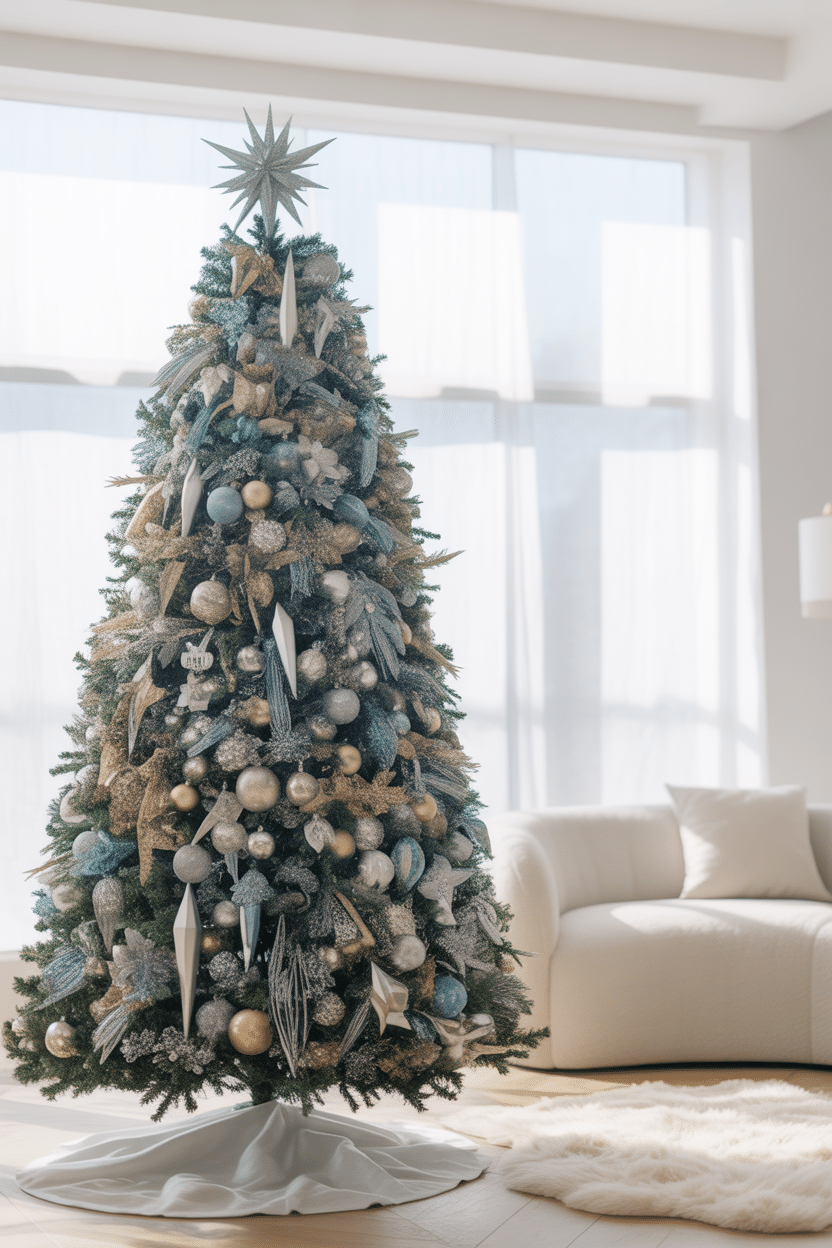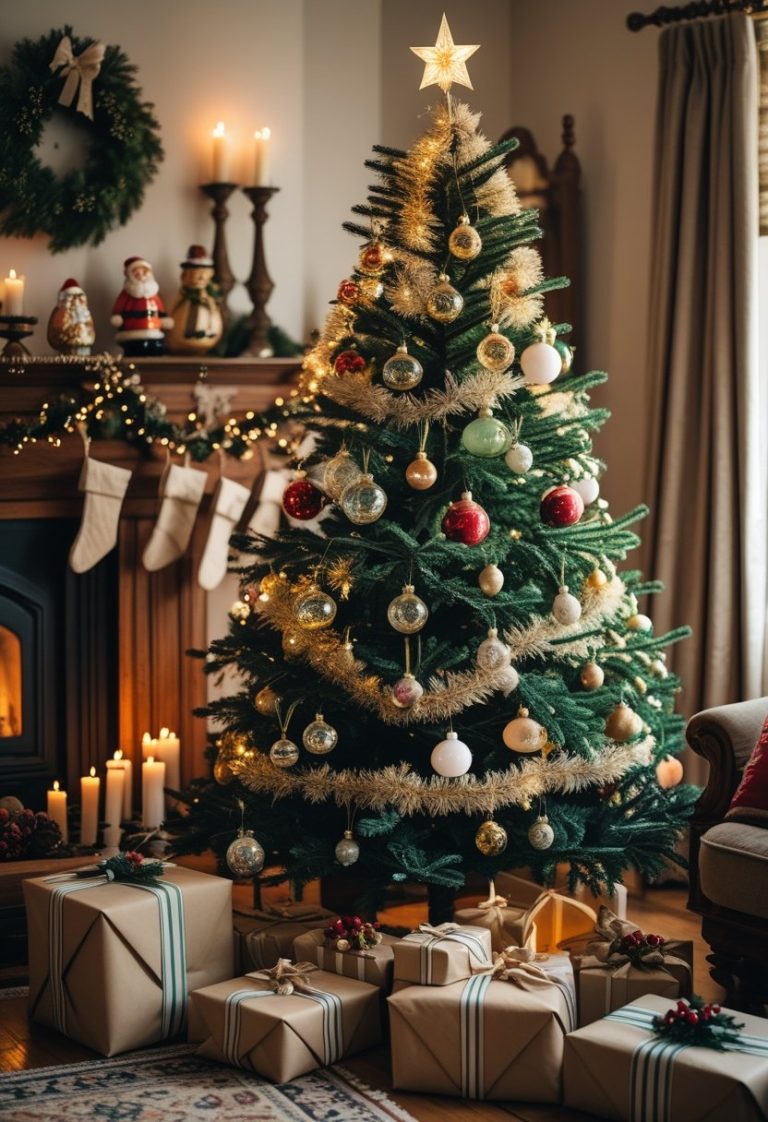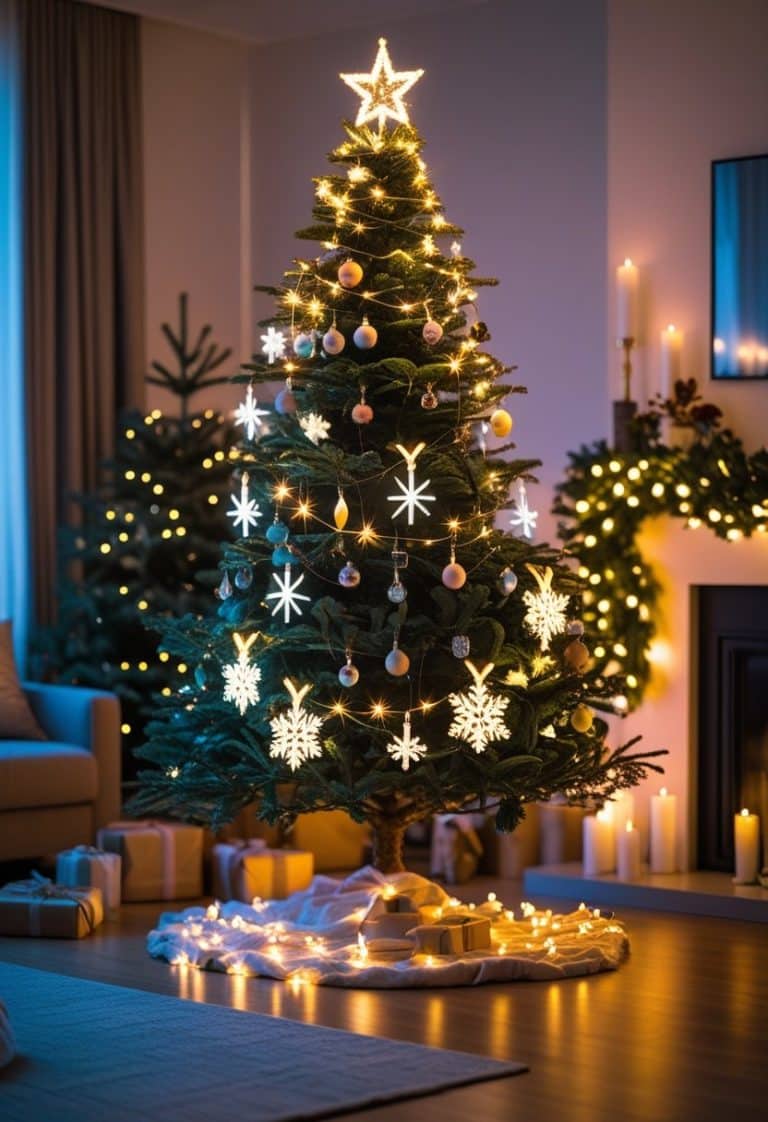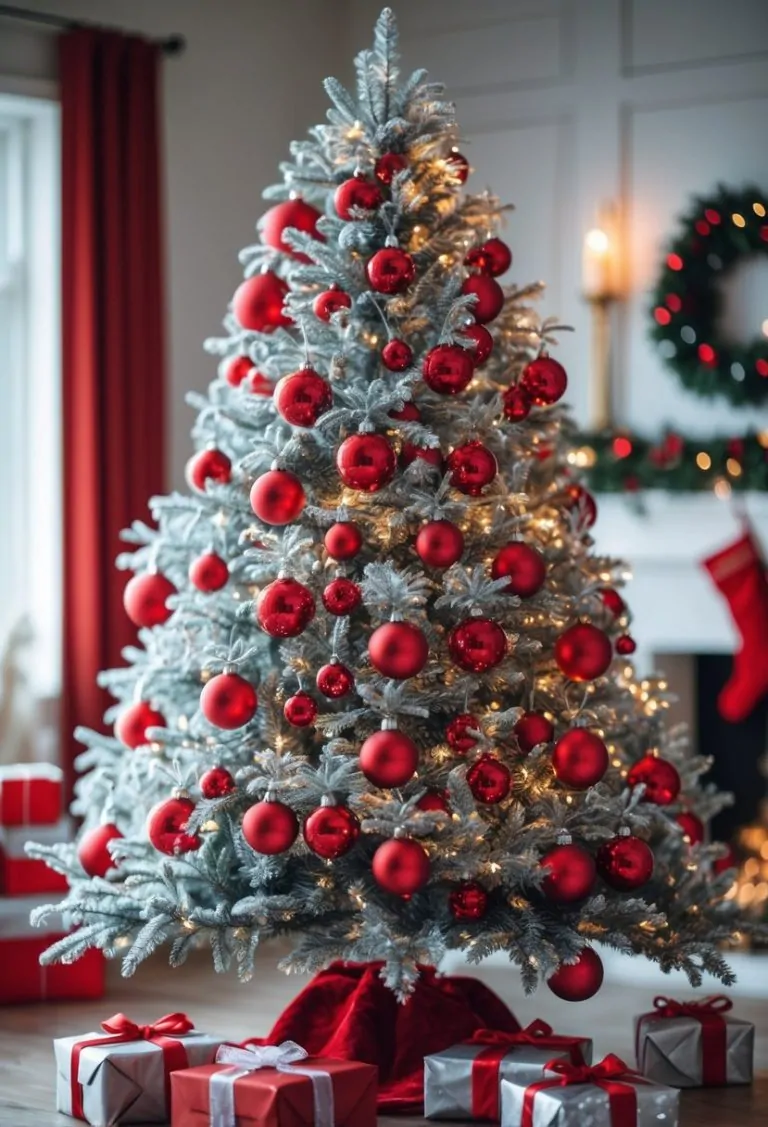Christmas Tree Trends 2025: 22 Stylish Ideas Shaping Holiday Decor

Every holiday season brings new ways to decorate and celebrate, and 2025 is no different. From timeless classics to bold modern twists, Christmas tree styling continues to evolve with fresh ideas that fit every taste and space. This year’s trends highlight creativity, comfort, and sustainability, offering inspiration for every kind of home.

Whether someone prefers the charm of vintage ornaments or the sparkle of high-tech lighting, there’s a trend that captures the spirit of the season. The mix of traditional elegance and playful updates makes decorating a tree more personal and expressive than ever before.
Classic Red Velvet Theme

The classic red velvet theme remains a favorite for 2025. It combines deep red tones with soft textures that create a warm, traditional look.
Designers pair red velvet ribbons, ornaments, and garlands with gold or metallic accents. This mix adds elegance while keeping the tree’s style timeless and inviting.
Whimsical Disney Decorations

Disney-inspired Christmas trees bring a playful and nostalgic touch to holiday décor.
Families often choose ornaments shaped like beloved characters such as Mickey Mouse or Disney princesses.
Bright colors, themed ribbons, and small figurines create a cheerful look that appeals to both children and adults.
Miniature Trees Throughout the Home

Miniature Christmas trees appear in more rooms than ever in 2025.
People place them on desks, kitchen counters, and entry tables to add small touches of holiday spirit.
These compact trees often feature simple lights or natural decorations, offering an easy way to bring festive charm without taking up much space.
Fibre Optic Light Revival

Fibre optic Christmas trees are returning in 2025 with improved lighting technology and energy efficiency.
These trees use built-in fibers that shift colors and brightness, removing the need for extra string lights.
Homeowners appreciate their clean design, low maintenance, and modern glow that fits both classic and contemporary décor styles.
Glittering Tinsel Accents

Tinsel makes a quiet return in 2025, adding shimmer without overpowering the tree.
Designers use thinner strands and metallic tones like silver, gold, and champagne for a balanced sparkle.
When placed near lights, the reflective surface enhances brightness and gives the tree a polished, festive look.
Luxe Gold Pre-Lit Trees

Luxe gold pre-lit trees bring a warm, elegant glow to holiday décor. Their built-in lights create an even shine that reduces setup time.
Many designs feature metallic branches and subtle shimmer for a refined look. They pair well with neutral ornaments and simple ribbons for a sophisticated holiday style.
Alternative Upside-Down Trees

Upside-down Christmas trees continue to attract attention in 2025 for their modern look and space-saving design.
They hang from ceilings or stand on inverted bases, leaving more room for gifts and decorations below.
Many choose them for their unique style and ability to highlight ornaments more evenly.
Sustainable Tree Rentals

Many people now rent live Christmas trees instead of buying cut ones.
Tree rental companies deliver potted trees, then collect and replant them after the holidays.
This approach reduces waste and supports local growers while keeping the tradition of a real tree alive.
Pink Christmas Trees

Pink Christmas trees continue to gain attention in 2025 for their soft and modern look. They fit well in both traditional and contemporary homes.
Many people use pink trees to create a cheerful and personalized holiday display. The color pairs well with metallic ornaments, white lights, or minimal decorations.
Oversized Baubles

Oversized baubles continue to shape Christmas tree design in 2025.
They add visual impact without needing many other decorations.
Many stores feature large ornaments in metallic, glass, or matte finishes.
These pieces work well on both traditional and modern trees, creating a balanced and eye-catching look.
Chic Bow Embellishments

In 2025, bows take center stage as a key Christmas tree accent.
Designers favor soft velvet, satin, and recycled fabrics for a refined yet sustainable look.
Muted tones like blush, cream, and sage replace the usual red and green, giving trees a calm, modern style.
Bold Textures on Trees

In 2025, Christmas trees feature more texture through layered materials and mixed finishes.
Designers use velvet ribbons, linen garlands, and knitted ornaments to create depth and warmth.
Natural elements like pinecones, dried citrus, and wooden beads add contrast, giving trees a tactile, inviting look without overwhelming the overall design.
Eco-Friendly Ornaments

Many people in 2025 choose ornaments made from recycled glass, wood, or metal.
They often avoid plastic and instead use natural materials like dried fruit, paper, or clay.
These choices reduce waste and support sustainable decorating habits while keeping the tree stylish and simple.
Maximalist Tree Designs

Maximalist tree designs in 2025 focus on bold color, texture, and variety. They feature layered ornaments, mixed materials, and rich patterns that create visual depth.
Designers pair metallics, velvets, and glass accents to achieve a full, vibrant look. Every branch becomes part of the display, leaving little empty space.
Minimalist Elegant Styles

In 2025, minimalist Christmas trees highlight clean lines and simple color palettes.
They often feature neutral tones like white, beige, and soft gold with a few well-placed ornaments.
Designers focus on quality materials such as glass, wood, and linen to create a calm, refined look that feels timeless and balanced.
Cottagecore Vibes

Cottagecore Christmas trees in 2025 highlight nature-inspired charm and handmade details.
They use soft colors, dried orange slices, wooden ornaments, and simple ribbons for a cozy look.
Many decorators mix vintage pieces with natural textures to create a calm, nostalgic atmosphere that feels warm and inviting.
Retro Disco Ball Decorations

Retro disco ball decorations bring a classic 1970s touch to Christmas trees in 2025.
They use mirrored ornaments that reflect light and create a soft shimmer across the room.
Many people pair them with bright colors or metallic tinsel to add a fun, nostalgic look without overwhelming the tree’s natural charm.
Colorful Whimsy Themes

Colorful whimsy themes bring playful energy to Christmas décor in 2025.
These trees feature bright ornaments, mixed textures, and bold color pairings like pink, teal, and gold.
Designers note that oversized baubles, ribbons, and unique ornaments help create a cheerful, imaginative look that feels both modern and inviting.
Nostalgic Vintage Ornaments

Vintage ornaments return in 2025 as a favorite choice for holiday decorating.
People choose hand-painted glass, mercury finishes, and retro patterns that reflect designs from the 1940s to 1960s.
These nostalgic pieces add warmth and familiarity, connecting modern celebrations with memories of earlier Christmas traditions.
Personalized Name Tags on Branches

Many families add personalized name tags to their Christmas trees in 2025.
These small ornaments often feature engraved or laser-cut names made from wood, metal, or acrylic.
They help identify each family member’s place on the tree and create a simple, meaningful touch that fits both modern and traditional decorating styles.
Themed Trees for Children’s Rooms

Children’s rooms often feature smaller, themed trees that reflect their interests. These trees may include soft ornaments, colorful lights, and playful decorations.
Popular ideas include themes like animals, storybook characters, or favorite colors. Using lightweight and shatterproof ornaments keeps the design safe and child-friendly.
Tabletop Trees in Kitchens

Tabletop trees add a festive touch to kitchens without taking up much space.
They fit well on counters, shelves, or breakfast nooks, bringing holiday charm to everyday areas.
Many people choose small pre-lit or mini artificial trees for easy setup and a clean look that complements kitchen décor.
The Evolution of Christmas Tree Decor

Christmas tree decorating has changed from simple candle-lit evergreens to designs that reflect culture, technology, and sustainability. Trends now mix tradition with new materials, lighting, and color choices that adapt to modern lifestyles.
Historical Influences on Modern Trends
Early Christmas trees in the 16th and 17th centuries featured handmade ornaments, candles, and edible decorations like apples and nuts. These early styles emphasized simplicity and symbolism rather than glamour.
By the 19th century, Victorian glass ornaments and metal tinsel became popular in Europe and later in America. The introduction of electric lights in the early 1900s replaced candles, improving safety and allowing more creative displays.
Mid-20th century trends reflected cultural shifts. The 1950s introduced aluminum trees and color wheels, showing interest in modern design. The 1980s revived natural looks with pinecones, ribbons, and handcrafted ornaments.
Today’s trends—such as pre-lit trees, mini trees for smaller spaces, and eco-friendly rentals—combine these influences. The focus remains on personalization and convenience, drawing from both nostalgic and modern inspirations.
Shifts in Color Palettes and Materials
Color use has moved from classic red, green, and gold to more varied combinations. Recent years favor earth tones, soft metallics, and pastel accents that match home décor rather than stand apart from it.
Table: Popular Color Themes by Era
| Era | Common Colors | Notes |
|---|---|---|
| 1950s | Silver, Blue | Reflective metallics |
| 1980s | Red, Gold | Traditional warmth |
| 2020s | Neutral, Pink, Green | Natural and calming tones |
Materials have also evolved. Glass remains timeless, but wood, recycled plastic, paper, and fabric now appear more often. These choices reflect interest in sustainability and texture variety, giving trees a balanced mix of old-world charm and modern design sensibility.
Sustainability and Eco-Friendly Choices

Many consumers in 2025 choose Christmas trees and decorations that reduce waste and energy use. They focus on materials that last for years and lighting that saves power without losing brightness or color quality.
Reusable and Recycled Materials
Shoppers now prefer artificial trees made from recycled PVC or bio-based plastics. These materials reduce landfill waste and lower the demand for new plastics. Some brands also use reclaimed wood or natural fibers for tree stands and ornaments, creating a more sustainable setup.
Rental programs have become popular. Families can rent real potted trees that are replanted after the holidays. This option cuts down on tree disposal and supports reforestation efforts.
A growing number of companies label their products with recyclability ratings or eco-certifications, helping buyers make informed choices. Even packaging often uses compostable cardboard or minimal plastic wrapping to reduce environmental impact.
Key examples:
| Material Type | Eco Benefit | Common Use |
|---|---|---|
| Recycled PVC | Reduces plastic waste | Artificial trees |
| Reclaimed wood | Reuses existing materials | Tree bases, ornaments |
| Potted evergreens | Replanted after use | Living trees |
Energy-Efficient Lighting Solutions
Modern Christmas lights use LED technology, which consumes up to 80% less energy than older incandescent bulbs. LEDs also last longer, reducing replacement waste and cost.
Many models now include smart controls that let users set timers or adjust brightness through mobile apps. This feature prevents lights from staying on unnecessarily and saves power.
Some households use solar-powered or USB-rechargeable lights, especially for outdoor displays. These options cut electricity use and work well in areas with mild winter sunlight.
Manufacturers also design low-voltage light strings that stay cool to the touch, improving safety and reducing fire risk. Together, these updates make holiday lighting both efficient and practical.






